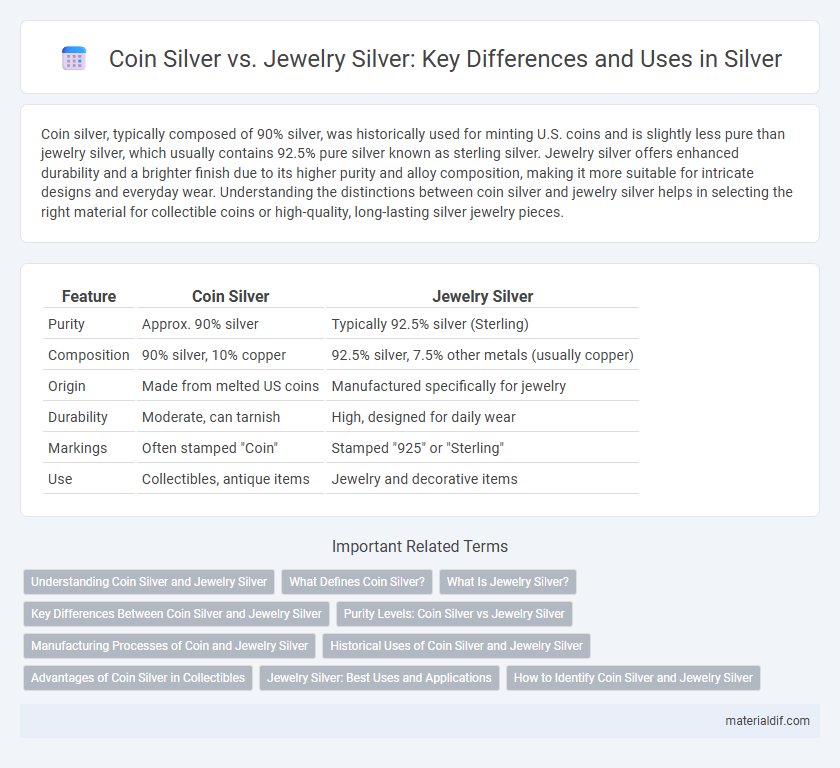Coin silver, typically composed of 90% silver, was historically used for minting U.S. coins and is slightly less pure than jewelry silver, which usually contains 92.5% pure silver known as sterling silver. Jewelry silver offers enhanced durability and a brighter finish due to its higher purity and alloy composition, making it more suitable for intricate designs and everyday wear. Understanding the distinctions between coin silver and jewelry silver helps in selecting the right material for collectible coins or high-quality, long-lasting silver jewelry pieces.
Table of Comparison
| Feature | Coin Silver | Jewelry Silver |
|---|---|---|
| Purity | Approx. 90% silver | Typically 92.5% silver (Sterling) |
| Composition | 90% silver, 10% copper | 92.5% silver, 7.5% other metals (usually copper) |
| Origin | Made from melted US coins | Manufactured specifically for jewelry |
| Durability | Moderate, can tarnish | High, designed for daily wear |
| Markings | Often stamped "Coin" | Stamped "925" or "Sterling" |
| Use | Collectibles, antique items | Jewelry and decorative items |
Understanding Coin Silver and Jewelry Silver
Coin silver typically contains approximately 90% silver and 10% copper, used primarily in vintage coins and some collectible items, offering durability and a distinct patina. Jewelry silver, often sterling silver, consists of 92.5% silver blended with 7.5% other metals like copper or zinc, providing enhanced strength and a bright finish suitable for intricate designs. Understanding these compositions is crucial for assessing value, durability, and suitability for various uses in silver crafting and collecting.
What Defines Coin Silver?
Coin silver is defined by its specific silver content, traditionally containing approximately 90% pure silver mixed with 10% copper, which distinguishes it from sterling silver that contains 92.5% silver. This alloy ratio originated from the silver used in circulating coins, making coin silver valuable for its historical authenticity and durability. Unlike jewelry silver, coin silver's composition prioritizes metal content over decorative quality, often influencing its use in collectible coins and antique silverware.
What Is Jewelry Silver?
Jewelry silver typically refers to sterling silver, an alloy consisting of 92.5% pure silver and 7.5% other metals, usually copper, designed for durability and resistance to tarnish. Unlike coin silver, which contains 90% silver and 10% copper, jewelry silver offers enhanced strength and shine, making it ideal for intricate designs and everyday wear. Sterling silver is stamped with "925" to indicate its standard purity, distinguishing it from lower-grade silver used in coins.
Key Differences Between Coin Silver and Jewelry Silver
Coin silver typically contains 90% silver and 10% copper, making it more durable and ideal for minting coins, while jewelry silver usually consists of sterling silver with 92.5% silver and 7.5% other metals, balancing purity and strength for decorative purposes. Coin silver's lower silver content results from historical alloy standards, whereas jewelry silver adheres to modern regulations ensuring higher silver purity for aesthetic appeal. The key differences between coin silver and jewelry silver lie in their silver purity, alloy composition, and intended use, influencing durability and value.
Purity Levels: Coin Silver vs Jewelry Silver
Coin silver typically contains about 90% silver and 10% copper, reflecting the standard used in US coins from the 19th century. Jewelry silver, especially sterling silver, is composed of 92.5% silver and 7.5% other metals, primarily copper, ensuring greater durability and a higher purity level. The difference in purity affects the metal's appearance, strength, and suitability for various applications such as coin minting or intricate jewelry design.
Manufacturing Processes of Coin and Jewelry Silver
Coin silver, traditionally composed of 90% silver and 10% copper, undergoes precise alloying and rolling processes to meet durability and standardization required for currency minting. Jewelry silver, often sterling silver at 92.5% purity, involves melting, alloying, casting, and detailed finishing techniques such as engraving and polishing to achieve intricate designs. Both manufacturing processes prioritize purity and malleability but differ in shaping methods and surface treatments to suit their specific functional and aesthetic purposes.
Historical Uses of Coin Silver and Jewelry Silver
Coin silver historically contains approximately 90% silver and 10% copper, used primarily in the 18th and 19th centuries for minting U.S. coins and American silverware. Jewelry silver, often sterling silver with 92.5% silver content, became prominent in the late 19th century, favored for its durability and luster in decorative items. The distinction in composition and use reflects evolving economic demands and technological advances in metalworking through history.
Advantages of Coin Silver in Collectibles
Coin silver, typically composed of 90% pure silver and 10% copper, offers superior durability and resistance to wear compared to the softer sterling silver used in jewelry. Its historical significance, often tied to mint-marked collectible coins, enhances its value among collectors seeking authenticity and preservation. The unique patina and original minting details found on coin silver pieces provide an added layer of aesthetic and investment appeal absent in most jewelry silver items.
Jewelry Silver: Best Uses and Applications
Jewelry silver, primarily composed of sterling silver with 92.5% purity, offers superior durability and a brilliant luster ideal for crafting fine accessories. Its applications include rings, necklaces, bracelets, and earrings where both aesthetic appeal and resistance to tarnish are essential. Unlike coin silver, which contains only 90% silver and is often used for collectibles, jewelry silver's higher purity enhances its hypoallergenic properties and long-lasting shine.
How to Identify Coin Silver and Jewelry Silver
Coin silver typically contains 90% silver and 10% copper, identifiable by its stamp marked "925," "90%," or "coin silver," while jewelry silver, often sterling silver, has a higher purity of 92.5% silver and is frequently marked with "925" or "sterling." To distinguish them visually, coin silver usually has a duller, darker patina compared to the brighter, shinier finish of jewelry silver.
Coin Silver vs Jewelry Silver Infographic

 materialdif.com
materialdif.com